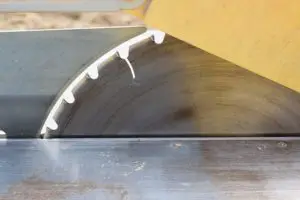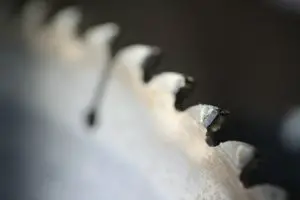If you have ever experienced a kickback while operating a saw, you know how scary it can be. Unfortunately, there is no way to know when a kickback can occur. When they happen, the damage is done in a split second. Best case scenario, you lose a board and maybe have to patch some drywall. Worst case scenario, it involves a visit to the emergency room and may even result in the loss of limbs. Since we can’t predict when a kickback will occur, we have to focus on reducing the risk of them occurring. Fortunately, there are options available to help with this.
Anti-kickback pawls are saw attachments that reduce kickback while operating a saw. They reduce the risks of injury and equipment damage. They can be installed on table and radial arm saws. They do not come with all saws, so in some cases you will have to buy them separately. European saws do not use anti-kickback pawls at all.
What Is Kickback?
When you feed a board into an electric saw, you push it against the direction that the saw turns. Kickback refers to the violent motion that occurs when control is lost while cutting with an electric saw. The saw spins fast enough for kickback to turn the board into a missile, firing it in whatever direction the saw is spinning. Worse yet, sudden kickback can cost you fingers if your hand gets jerked into the saw.
Kickback is a serious safety hazard that you must prepare against. A quick search on YouTube finds several clips where people have caught their incidents on camera. In this video, you can see how close one man came to losing fingers in fractions of a second while using a table saw. This will make the idea of kickback real and you will better understand why you need to protect yourself. One way to do this is with anti-kickback pawls.
What Is An Anti-kickback Pawl?
 A pawl is a type of latch that prevents movement. Anti-kickback pawls reduce kickback as you feed a board through a saw. Anti-kickback pawls look like two tiny saws joined together, each having pointed teeth. Those teeth hang behind the saw so that when you push wood through, they will run across the top of the wood. They are designed to allow wood to go by as long as it is pushed against the saw. In the event of kickback, the design of the teeth causes them to dig into the board to hold it in place.
A pawl is a type of latch that prevents movement. Anti-kickback pawls reduce kickback as you feed a board through a saw. Anti-kickback pawls look like two tiny saws joined together, each having pointed teeth. Those teeth hang behind the saw so that when you push wood through, they will run across the top of the wood. They are designed to allow wood to go by as long as it is pushed against the saw. In the event of kickback, the design of the teeth causes them to dig into the board to hold it in place.
What saws can you install them on?
You use anti-kickback pawls with table and radial arm saws. A table saw is workbench with a circular saw blade run by an electric motor. The blade sticks out of the table and wood is pushed through it. A radial arm saw is an electric saw attached to a cutting board by an arm that makes the position of the blade adjustable.
These two saws offer different benefits. Table saws can be used to cut metals and plastics in addition to wood. The radial arm saw requires less workspace than a table saw. Radial arm saws also only require space cleared to the sides, whereas table saws require clearance to the front, back, and sides. Table saws tend to be much less expensive than radial arm saws.
Injury statistics. The “kickback on camera” YouTube video mentioned earlier shows kickback happen on a table saw. According to the United States National Center for Biotechnology Information, each year more than 30,000 table saw injuries happen, usually to the hands and fingers. The medical costs from these injuries exceed two billion dollars.
The radial arm saw injury statistics are in the hundreds per year. Those numbers are much lower than those of the table saw due to miter saws mostly replacing them in the 1970s. Some users claim that miter saws are safer and more accurate. Other users continue to use radial arm saws for niche features not offered by miter saws, such as making rip and dado cuts. New woodworkers should not user radial arm saws without experienced supervision because the extensive mobility of the blade increases the risk of harm.
When Should You Use Anti-Kickback Pawls?
You can only use anti-kickback pawls on through cuts. A through cut is “a sawing operation in which the workpiece is completely sawn through.” These are simple cuts like when you want to split a board in two, reduce the length of the board, cut the board on angle to use as a door frame, and so on.
 When not to use anti-kickback pawls. While they are valuable to use in certain situations, there are complaints about using them in others. They become less effective when they are nearly as wide as the board. Some users complain about the pawl scraping the wood (more noticeable with softer wood), getting in the way or making the cut awkward.
When not to use anti-kickback pawls. While they are valuable to use in certain situations, there are complaints about using them in others. They become less effective when they are nearly as wide as the board. Some users complain about the pawl scraping the wood (more noticeable with softer wood), getting in the way or making the cut awkward.
You cannot do partial cuts with anti-kickback pawls because their teeth will prevent you from pulling the wood out. You also cannot perform dado cuts, which are partial cuts where small chunks of the wood are removed.
User reviews: criticism and praise. A user on one woodworking forum compared not using anti-kickback pawls to not wearing a seatbelt while driving. Another user on a different forum claimed that “if the riving knife does its job, the anti-kickback pawls are overkill.” You can find entire forum threads dedicated to one side or the other, so beware of bias if you decide to quickly scan woodworking forums for opinions on anti-kickback pawls.
Do anti-kickback pawls come standard?
Anti-kickback pawls do not come with all saws. As mentioned earlier, they are used with table saws and radial arm saws for through cuts only. Even among those two types of saws, anti-kickback pawls do not come standard with all models. Be sure to check the production description of the saw that you might buy if you are expecting anti-kickback pawls to come with your machine.
Anti-kickback pawls do not appear on European saws. European models have a different guard design that makes them unnecessary. American table and radial saws allow for the use of anti-kickback pawls. The American Occupational Safety and Health Administration (OSHA) requires that anti-kickback devices be used on table saws in the workplace.
You can purchase anti-kickback pawls separately online from sites like Amazon or eBay. You can find videos on YouTube with a “how to install anti-kickback pawls” search. These will show you how to install them on your saw in less than five minutes. Some of these videos also include setting up other safety features like blade guards in addition to your anti-kickback pawls.
What else should you know?
It should go without saying that no one safety device can make a saw 100% safe. While anti-kickback pawls will reduce your risk of injury or equipment damage do not neglect to act carefully and to use other safety equipment. Make sure that your saw is secure before operating, clear the space around your work station, consider using safety goggles, and do not stand in a way where you could lose your balance.
Be mindful of the small gap between the saw and the anti-kickback pawls where you are vulnerable to kickback. Because the wood has not yet reached the teeth of the pawls, there is a brief window where you are vulnerable to kickback.
Remember that after enough use the teeth on anti-kickback pawls will begin to dull, which will reduce their ability to stop kickback. Be sure to routinely inspect them before using them with your saw. You will need to replace them if they become too dull or if they get damaged in some other way.
Using other safety gear with anti-kickback pawls. Equipment like riving knives and blade guards can be used together with anti-kickback pawls. A riving knife is a safety attachment that you attach to the saw’s arbor to stop jamming that could lead to kickback. Blade guards cover the blade to protect your fingers and prevent splinters of wood from shooting off the saw. You can attach both anti-kickback pawls and blade guards together to certain types of riving knives, allowing for additional protection.




